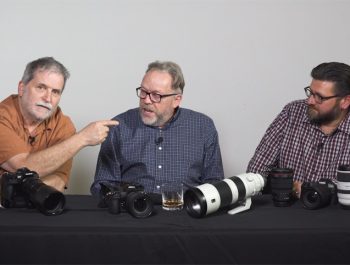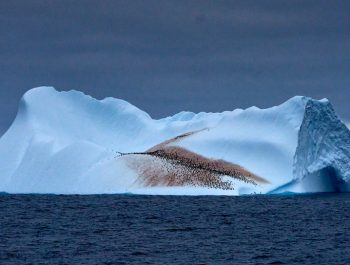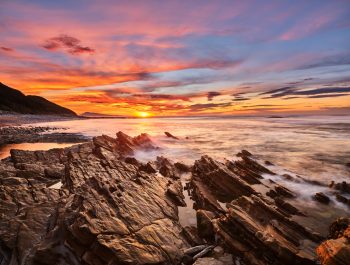New Camera at Big Sur – The Leica M-10 Monochrom
Playing with a new Leica M-10 Monochrom
on a visit to the Big Sur and the Monterey Peninsula
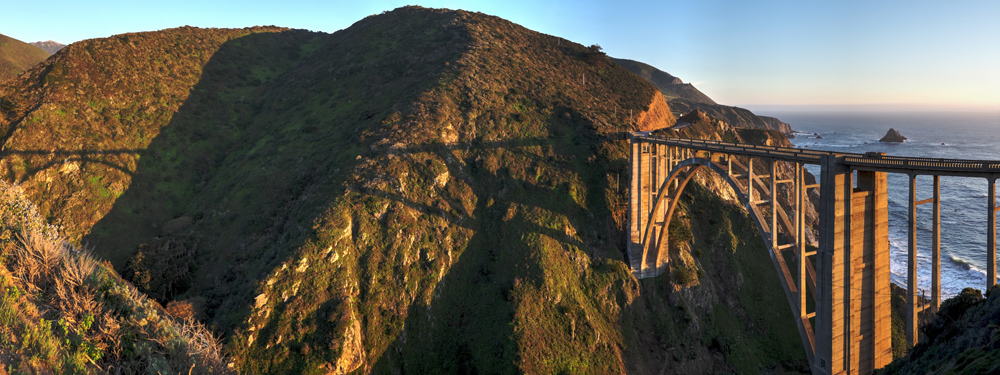
The Trip
Sometimes timing can be great and terrible at the same time. In the summer of 2019, my wife and I planned a March 2020 trip to Carmel, California. We planned to spend three weeks escaping from the snowiest month in our home state of Colorado. Don’t get me wrong, Colorado’s mountains are spectacular in the winter. But we have been experiencing them for decades. In January Leica announced the new M-10 Monochrom camera.
I bought the first Leica Monochrom camera many years ago and upgraded to the next one a few years later. The original CCD sensor-based camera was great, a very unique concept. A digital camera with no color filter over the sensor. It only captured luminosity. That meant its 18-megapixel sensor performed to a higher resolution than other comparable color sensors with their separate RGB pixels. The second Monochrom camera was, of course, not as revolutionary. But it did increase the sensor size to 24 megapixels and improved the low light capability. I hadn’t bought the first Monochrom as soon as it came out, nor the second. It took me a while to get my head around the idea of owning a camera that only took black and white photos. And the reason I justified the second was an upcoming trip to England to photograph the interior of Durham Cathedral. The added resolution and improved low light ability were perfect for my trip. When the third camera was announced I scrambled to find one. I knew I wanted it. The resolution jumped up to 41 megapixels and low light performance increased even more. Each of the three, in their time, have been outstanding in low light performance. But my scramble to find a camera was due to my upcoming trip to California. I did find one and then spent a few days up in Rocky Mountain National Park – about an hour from my home – to learn my new camera. Remember those great Colorado mountains with snow on them? In any case, the timing for my trip to California was perfect.
Over almost three weeks I traveled around the Monterey Peninsula and down the Big Sur taking photographs with my new camera. The peninsula is known mostly for its cypress trees. Just think of those golf tournaments at Pebble Beach. The Big Sur is known for its rugged coastline, redwoods, and some spectacularly engineered bridges. I even took along my micro-four-thirds camera system to take some color photos as well. But most of my time was spent with my new camera.
As the three weeks progressed, and I revisited favorite spots over and over, some dark clouds were forming. No, not the kind that makes for some great photography, although there were some of those. I am referring to the Coronavirus that had only just started to impact China in December. By the time we left California a few days earlier than planned the virus had spread around the world. For days we had been eating only take-out or home-cooked meals in our rental. At least we had a kitchen. On the drive home, we began to wonder if we would even be able to find take-out. As things turned out we did get home safely and didn’t have to skip any meals. But the timing was terrible.
The Camera
The Leica M-10 Monochrom really is an amazing camera. I think most people expected the next Monochrom would have a modest bump in resolution if any at all. The biggest improvement would be to bring the camera up to the features of the M-10 color camera which was released about three years earlier. The big sensor was a big surprise. Some of the reviews of the new camera even talked about the results from its sensor, without the color filter, as rivaling medium format cameras’ output. The camera’s low light quality has also been considerably improved. For comparison, I’ll use my benchmark numbers I used for my second Monochrom, model 246. I was generally happy with a jpg image right out of the camera that was properly exposed at 4,000 ISO. With post-processing using Neat Image, my B&W preferred noise reduction software, I was happy up to about 10,000. These are already impressive numbers in my opinion. Testing with the new Monochrom, my comparable numbers were 10,000 and 50,000. Amazing. On this trip, I did not do any testing of the new low light abilities though. That will have to wait for another time.
There have been a number of excellent reviews of the M-10 Monochrom camera posted on the Web. I have no desire to repeat what they say. Rather I want to share my experiences with the new camera and offer some images as well. In particular, I am not a very good reviewer of the camera’s new operating features anyway. I don’t tend to use the back panel except to occasionally look at an image I have taken. I have liked using a rangefinder since my first Leica CL (film camera) many decades ago. For exposure, I generally set the camera on A and then just aim at different areas of a scene in spot mode and see what the shutter speed should be. Then I figure out how I want to manually set it. When in doubt I may bracket. Leica’s Monochrom cameras have always had the issue that any areas of a scene that are overexposed are permanently blown out. There is no recovery by using one of the color channels like you can do with a color camera. Fortunately, the Monochrom cameras do a great job of recovering underexposed areas, so some underexposure is called for most of the time. The new camera also has one of the widest dynamic ranges of any digital camera to date. For the most part, I am an old-school photographer with a Monochrom camera. That seems a bit strange to me since with my color kit I use all sorts of new-fangled features. I guess it just has something to do with the feel of holding a Leica rangefinder in my hands.
Water, Coast, Trees, and Bridges
Water felt like the dominant characteristic of my trip. Even the photos of giant redwood and Cyprus trees were indirectly due to the frequent fog on this California coast. For those readers who have never been, this area of California coast is unique. In fact, it is the largest section of the protected coast in the lower 48 states. As you drive along the only road on this coast, California Route 1, it seems like it shouldn’t even be here. The numerous bridges that cross small streams are remarkable. The reason is those small streams explode during the heavy rains that frequent most winters. In the summer of 2016, a fire burned some of the areas and the next winter’s rains were more than 60 inches. The result was one destroyed bridge and two massive mudslides that closed the road until mid-2018. Probably the most spectacular bridge along the Big Sur – not the one destroyed – is the Bixby Bridge. It doesn’t just bridge the river and canyon, it curves while it does so. All the while doing it higher than the Golden Gate Bridge some miles to the north. I spent multiple trips photographing the bridge from different directions and distances and at different times of day in varied weather. In the end, I liked a panorama shot composed of seven stitched together images. Because of the great differences between the bright reflected sunlight off the ocean and darkness in some of the hillside, I used HDR to create each of the seven images. Here is the resulting final image, an 18×72 inch print.

Due to the large resolution of the sensor, I actually ended up reducing the size of the image for an 18-inch high print. One of the side effects of such large images is the size of files. The 7x3x2 files (shots x 3 for HDR x both jpg and RAW) take up over four gigabytes on my disk. Even leaving out the RAW files the size is over three gigabytes for the original jpg files and the stitched, and post-processing intermediate and final images. A large “film” card is desirable as well as some serious storage on your computer and backup drives.
The section of the coast I visited is known for two very different kinds of trees. Both are found, at least including similar kinds of trees, in other places. The redwoods are mostly known to be in Northern California. And they are bigger up there. But redwoods are impressive anywhere. The furthest south the redwoods grow is in the Big Sur. The best local groves are found in the middle of the Big Sur coast.
On a previous trip to the northern California coast, I found that photographing redwoods is a difficult business. First off, they are big, really big. In fact, they are the tallest species of tree in the world. Second, they tend to grow in groves, lots of trees together. It’s hard to see the tree for the forest. There is always the image of a little glimpse of the sky looking straight up through a bunch of trees. I’m sure mine would be much better that all of the other ones taken. If I wait long enough maybe I can get a bird or airplane in the sky. Maybe not. The print I ended up liking the most was one that focused on the many branches of one big tree. There is little to tell what the scale of such a big tree it is. But somehow the print felt like a big tree.
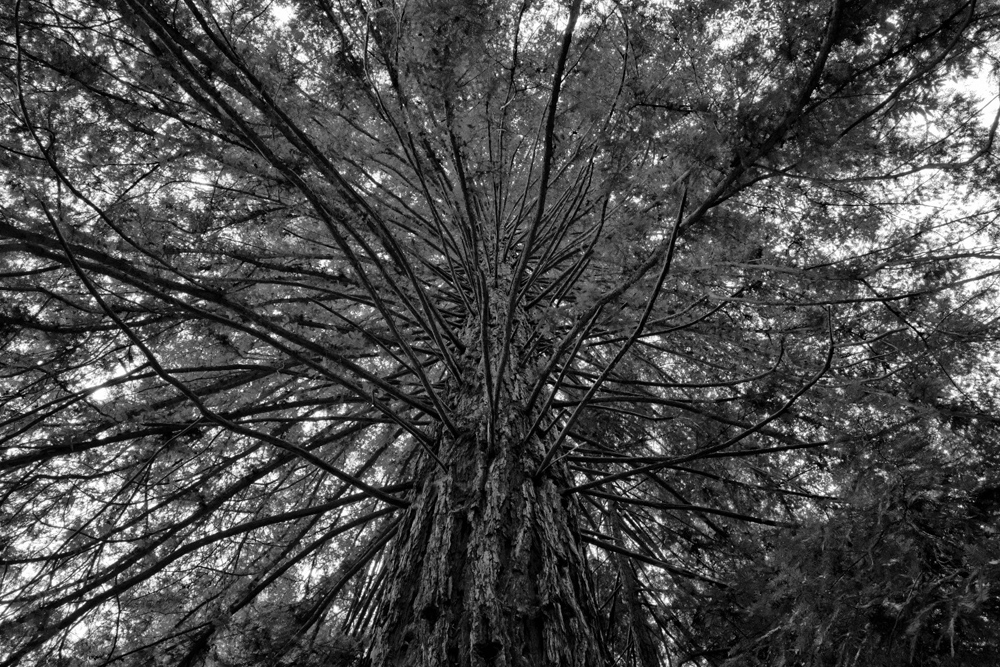
The print ended up being a 20×30 inch one. Since I used most of the photo it only needed to be enlarged slightly. It was quite dark in the forest, so I used an ISO of 10,000 and also used three bracketed shots combined for HDR. The result has a slight grain effect, but a pleasing one in my opinion. I could have passed it through some noise reduction but decided I liked it better with the grain. That is one of the nice things about a Monochrom cameras’ grain. It is a lot more pleasing than the chromatic noise found in color low-light images. This has been true for all three Monochrom cameras.
The other tree in this area of California is the Cyprus. Cyprus trees are found in many parts of the world. Most obviously it is found on the island of Cyprus. But the Monterey Cyprus is only found on the Monterey Peninsula and on Point Lobos. The famous lone Cyprus is along the 17-mile drive in Pebble Beach. But the best ones, in my opinion, are on Point Lobos. The Point is a state park and rated by visitors as the best park in the California system. The steep hillsides the Cyprus grow on would be spectacular even without the trees’ beautiful twisted branches. They are sculpted by the strong winds and the constant search for more light during a tree’s growth. They are nowhere near as old as the almost 2,000-year-old redwoods; Cyprus trees only grow around 100 years. But they seem much older, with their bent overlook. The print I liked the best from my trip was a hillside on Point Lobos with many Cyprus and one standing out from the rest. In this case, I used my 90mm Summarit-M f/2.4 lens. But the part of the image I liked the best for framing was still a relatively small part of the image. Fortunately, I only wanted to make a 12×12 inch print. Another one of the great advantages of the resolution of the new sensor is the ability to crop more aggressively.
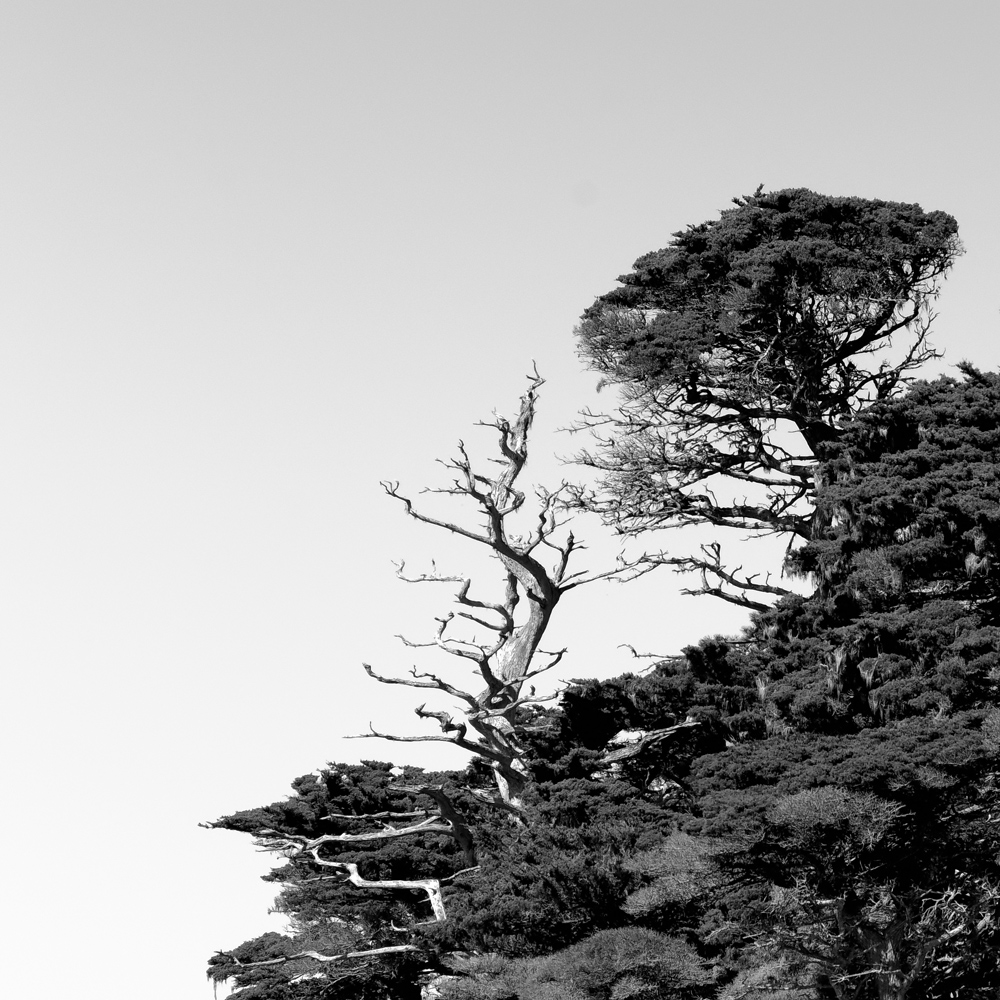
Spectacular hills, some with trees, plunging down to the Pacific Ocean is what Big Sur is all about. And it was the Pacific Ocean I found myself spending the most time photographing. Sometimes the waves would be big, sometimes almost nonexistent. Sometimes there would be magnificent clouds, but often just blue or grey. I found my biggest waves on a mostly grey day along the western shore of the Monterey Peninsula. From Point Pinos on the north to where the golf courses take over to the south, the shore is dominated by the Asilomar State Beach. Here you can climb out on volcanic rock made of quartz and other sharp materials. I wished I had some gloves. But the waves were just too tempting. Once I found a good place to stand with reasonable footing I waited for some big waves. Eventually, I was rewarded. The print I ended up creating was made from virtually all of a shot and only slightly enlarged to 20×30 inches. Yes, the sensor is that big.
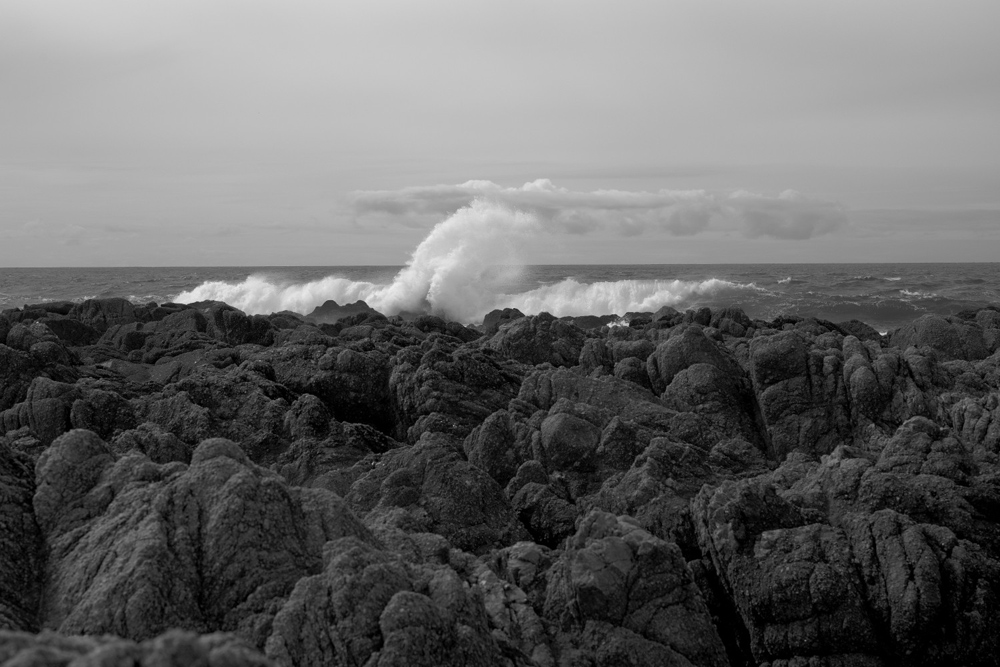
At this size, there is a lot of detail. When the M-10 Monochrom was announced there was speculation that at 40 megapixels such a high-resolution sensor would be beyond the resolving power of even great Leica lenses. Such a sensor would end up showing the limits of lens resolution. At least with my Summicron 50mm APO asph lens, I don’t think this is true and this image helps to prove it. On the next page is an enlargement of a part of the wave. The 1/4000 of a second shot froze it so that individual water drops can be seen. So far I have not been disappointed with any of my lenses with my new camera.
To get from the camera’s jpg to my final print I first had to underexpose the shot by a good deal. The brightness of the breaking water was very bright even on the somewhat overcast day. Then I worked to bring out some resolution in the dark rocks in the foreground. I did my slight enlarging and a final bit of sharpening. Besides the dramatic wave, I liked the way it looks like the wave is almost feeding the small clouds behind it.
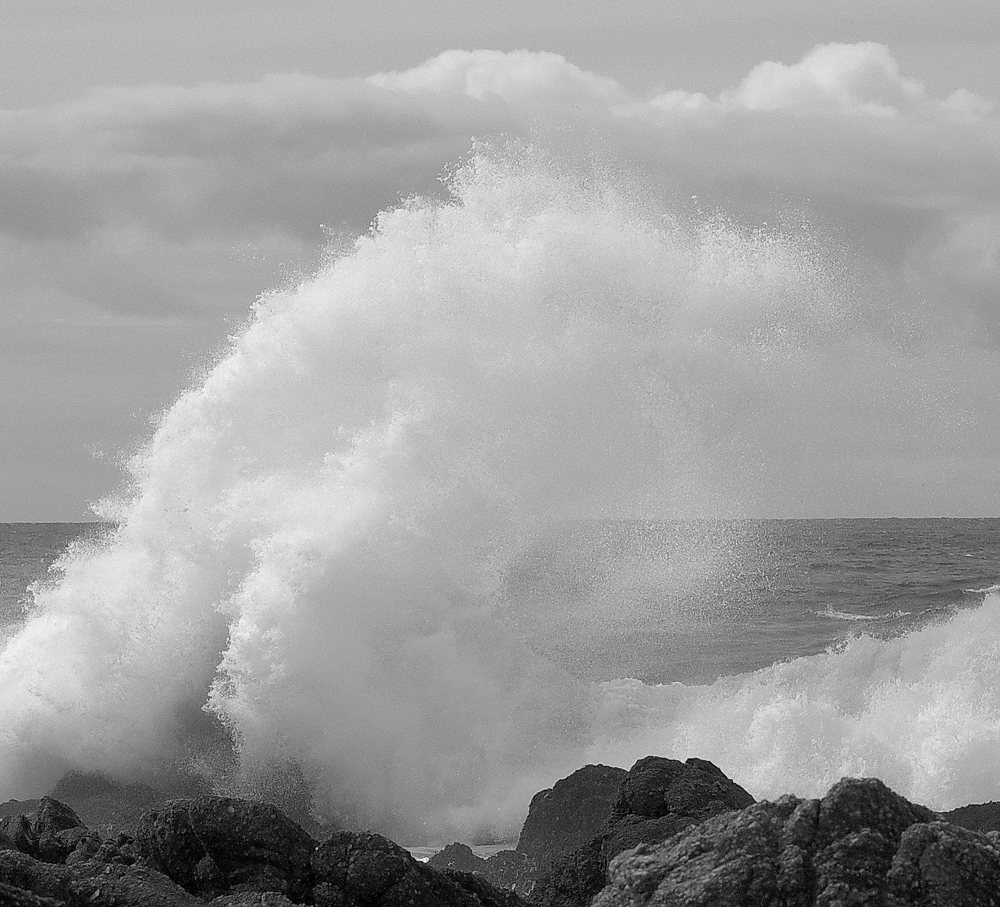
Another great place along the coast that I kept going back to was Garrapata State Park. Here there were many trails down from the road to spots to photograph the waves and the Big Sur cliffs. On another even greyer day, I stood for a long time watching and waiting for good waves. There was even a bit of fog to help with the photographic mood. As I stood there and I waited I began to notice how the last wave, as it receded, hindered the next one from breaking as big. But the receding water made some very interesting patterns. It almost looks like marble. And the next wave would be breaking further in the distance before it would hit the closer shore. In this way, I was watching the different stages of a wave from about to break to breaking against the rocky cliffs to receding in foaming patterns. Add to this the incoming waves waiting for their turns out in the ocean. With embarrassingly insufficient modesty the final print felt like something Ansel Adams might have done. Of course, his would be much better. However, having spent a number of years working with my 4×5 camera I am not sure how easy it would have been to get a fast enough exposure to catch this shot on a dark foggy day. Some readers may feel that I left the overall image too dark. But this is what the day was like. I try to present in my prints what I saw and felt.
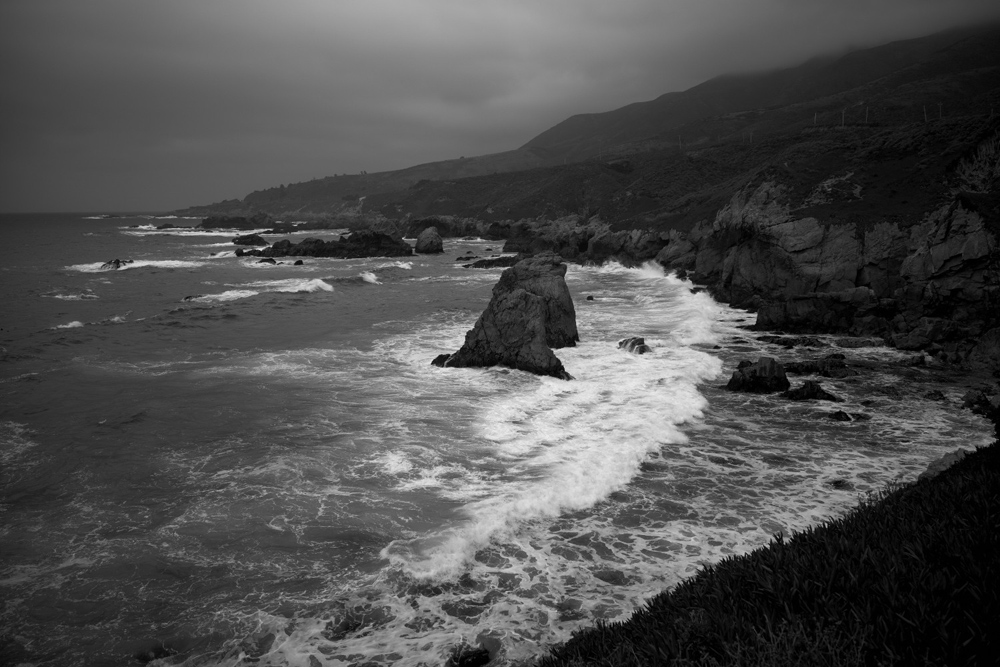
The subject matter in this shot seemed to beg me to make this print big. So I did. The final is 24×36 inches. That meant enlarging it by a little under 40%. With today’s digital darkroom capabilities the result was something I was very happy with. On the next page are two details from the final print.


The first shows the resolution of the enlarged print. The second shows the sky and the resulting grain-like noise. To repeat my earlier comment, I think B&W grain is a big advantage with Leica Monochrom cameras. When I have converted some noisy color shots into B&W images the grain still seems far “muddier”.
Because this is kind of a review of my new camera I would like to present one final sample from my trip. It is of some groundcover on Soberanes Point in Garrapata State Park. The final is an 8×10 inch print. It came from a much larger original image. In fact, the print is a landscape-oriented image extracted from a portrait-oriented shot. Even then I ended up shrinking the print down from the larger crop.
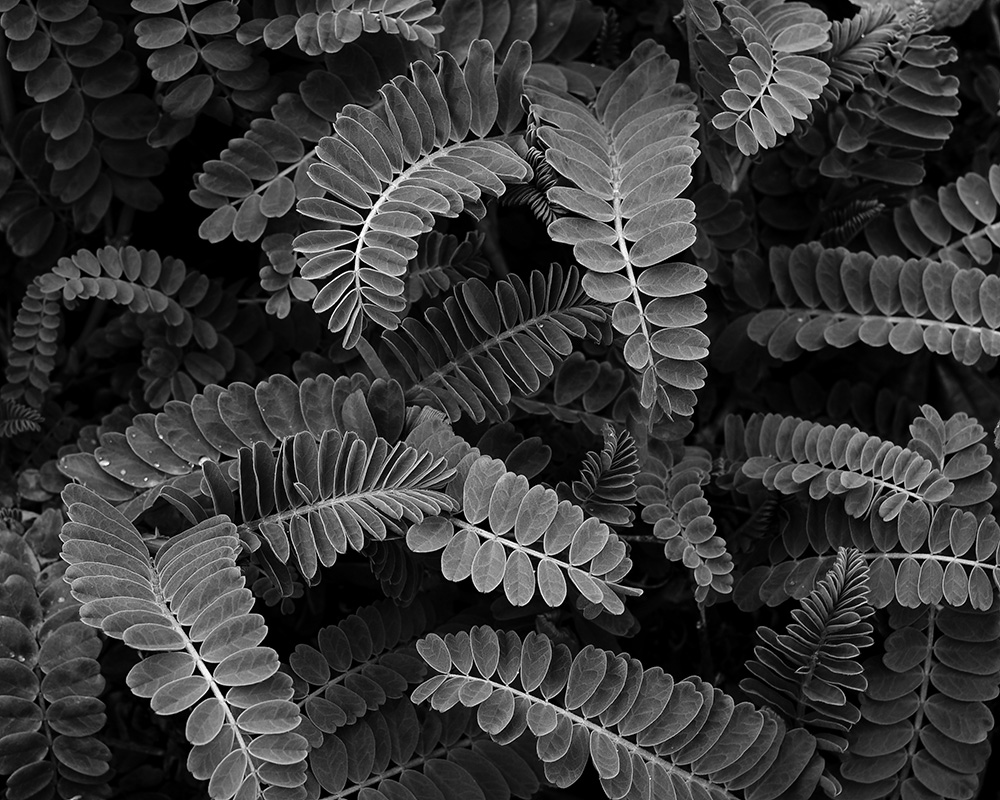
I am providing a full-sized (300dpi) jpg of the final print as well as the original DNG RAW file and out-of-the-camera jpg. Readers can view for themselves how this camera’s images look.
Download The DNG Raw
Download The Full-Size JPG
And finally, lest we all begin to start to believe that the world is really just made up of only shades of grey, I offer a truth.
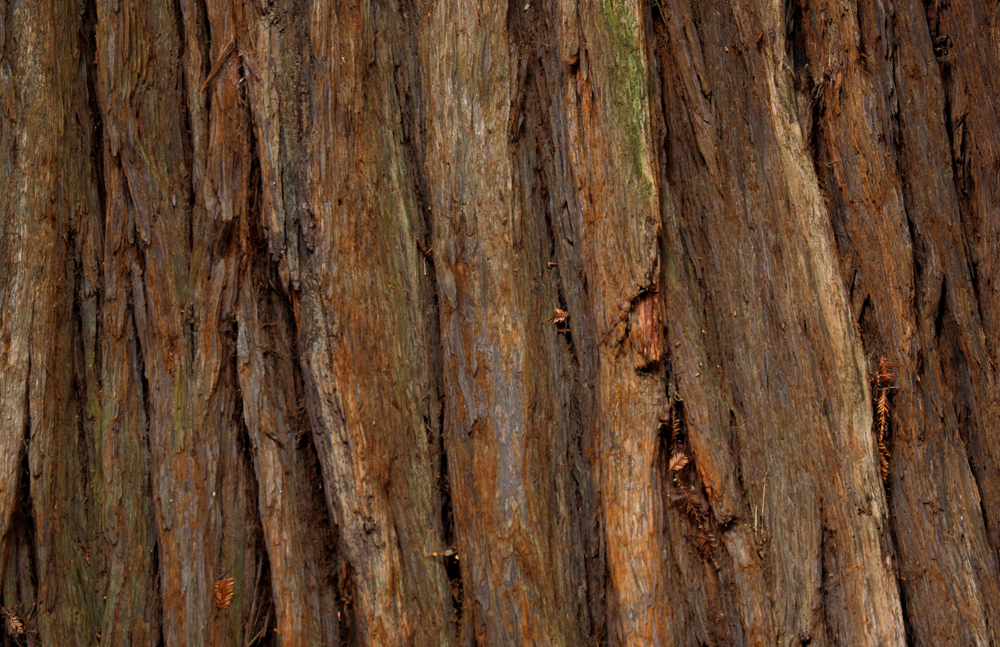
Reid Shay
August 2020
, CO
I love visiting Earth’s beautiful places and I want to record what I see. I do this to enjoy them again later and to share them with others. I do not try to record what I think other people will think is beautiful. My photos are for me and for me to share. I work hard to find the beauty in the places I visit. I work hard to perfect how my photos record what I see. Much of this is subjective. This is a continual process to better my seeing and my photography. I have been a photographer all my life. I have come to see things as my camera and my photographic skills let me. I can record more of a scene than a single picture allows, blur motion or remove color. I can select what is in focus and what is not. I do these things to bring out or emphasis the beauty of what I see rather than to try and make something more beautiful than it is. I think both the Earth and photography are wonderful. I have enjoyed both all my life and intend to continue to do so.






